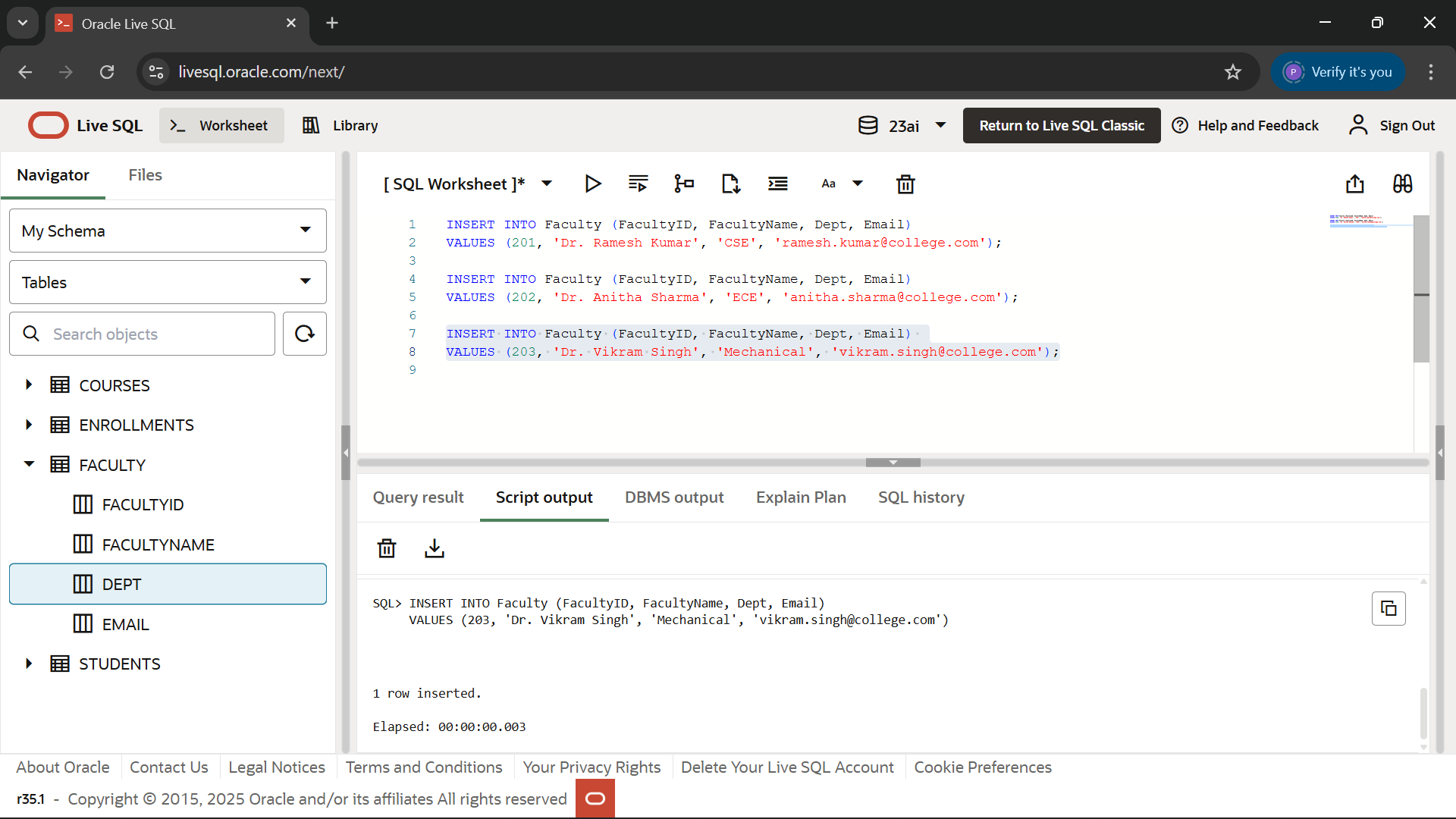Managing students, courses, and enrollments is one of the most common use cases in college management systems.
In this blog, we’ll design a Student & Course Management System in SQL and walk through 10 key operations: creating tables, inserting data, altering structure, defining constraints, using functions, joins, group by, views, and stored procedures.
Step 1 – Create the Students Table
We start by creating a Students table with basic details.
`CREATE TABLE Students (
StudentID NUMBER PRIMARY KEY,
StudentName VARCHAR2(50) NOT NULL,
Dept VARCHAR2(30),
DOB DATE,
Email VARCHAR2(50) UNIQUE
);
Step 2 – Insert Data into Students
Let’s insert some student records:
INSERT INTO Students (StudentID, StudentName, Dept, DOB, Email)
VALUES (101, 'Arun Kumar', 'CSE', DATE '2004-05-10', 'arun.kumar@college.com');
INSERT INTO Students (StudentID, StudentName, Dept, DOB, Email)
VALUES (102, 'Priya Sharma', 'ECE', DATE '2003-11-15', 'priya.sharma@college.com');
INSERT INTO Students (StudentID, StudentName, Dept, DOB, Email)
VALUES (103, 'Vikram Raj', 'Mechanical', DATE '2004-01-20', 'vikram.raj@college.com');
Step 3 – Alter Table to Add Phone Number
We can add new columns later. Here we add a 10-digit PhoneNo.
`ALTER TABLE Students
ADD PhoneNo VARCHAR2(10);

Step 4 – Create Courses Table
We’ll also need a Courses table to store course information.
CREATE TABLE Courses (
CourseID NUMBER PRIMARY KEY,
CourseName VARCHAR2(50) NOT NULL,
Credits NUMBER(2) CHECK (Credits BETWEEN 1 AND 5)
);
Step 5 – Enrollments Relationship (Many-to-Many)
A student can enroll in many courses, and a course can have many students.
So, we create an Enrollments table:
CREATE TABLE Enrollments (
EnrollID NUMBER PRIMARY KEY,
StudentID NUMBER REFERENCES Students(StudentID),
CourseID NUMBER REFERENCES Courses(CourseID),
Grade CHAR(2)
);
step 6 – Using SQL Functions
Example: display student names in uppercase and email lengths.
`SELECT UPPER(StudentName) AS StudentName_Upper,
LENGTH(Email) AS Email_Length
FROM Students;
Step 7 – Aggregate Functions
Find the average course credits and total number of students enrolled.
SELECT AVG(Credits) AS AvgCourseCredits FROM Courses
SELECT COUNT(DISTINCT StudentID) AS TotalStudentsEnrolled FROM Enrollments;
`
✅ Final Thoughts
With these steps, we have built a Student & Course Management System in SQL that includes:
Students table with constraints
Courses table
Enrollments table (many-to-many relationship)
Insert, alter, and constraints
Functions and aggregates
Joins and group by queries
Views for simplified reporting
Stored procedures for automation
Thankyou @santhoshnc sir for teaching about this and giving it as our assignment .This assignment is helpfull for me sir!!
This system forms the backbone of a college database project, and can easily be extended with Attendance, Results, or Faculty management.🚀





`
`



Top comments (0)